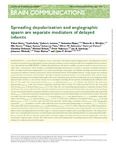2023-03-22Zeitschriftenartikel
Spreading depolarization and angiographic spasm are separate mediators of delayed infarcts
Horst, Viktor
Kola, Vasilis
Lemale, Coline L.
Major, Sebastian
Winkler, Maren K. L.
Hecht, Nils
Santos, Edgar
Platz, Johannes
Sakowitz, Oliver W.
Vatter, Hartmut
Dohmen, Christian
Scheel, Michael
Vajkoczy, Peter
Hartings, Jed A.
Woitzik, Johannes
Martus, Peter
Dreier, Jens P.
In DISCHARGE-1, a recent Phase III diagnostic trial in aneurysmal subarachnoid haemorrhage patients, spreading depolarization variables were found to be an independent real-time biomarker of delayed cerebral ischaemia. We here investigated based on prospectively collected data from DISCHARGE-1 whether delayed infarcts in the anterior, middle, or posterior cerebral artery territories correlate with (i) extravascular blood volumes; (ii) predefined spreading depolarization variables, or proximal vasospasm assessed by either (iii) digital subtraction angiography or (iv) transcranial Doppler-sonography; and whether spreading depolarizations and/or vasospasm are mediators between extravascular blood and delayed infarcts. Relationships between variable groups were analysed using Spearman correlations in 136 patients. Thereafter, principal component analyses were performed for each variable group. Obtained components were included in path models with a priori defined structure. In the first path model, we only included spreading depolarization variables, as our primary interest was to investigate spreading depolarizations. Standardised path coefficients were 0.22 for the path from extravascular bloodcomponent to depolarizationcomponent (P = 0.010); and 0.44 for the path from depolarizationcomponent to the first principal component of delayed infarct volume (P < 0.001); but only 0.07 for the direct path from bloodcomponent to delayed infarctcomponent (P = 0.36). Thus, the role of spreading depolarizations as a mediator between blood and delayed infarcts was confirmed. In the principal component analysis of extravascular blood volume, intraventricular haemorrhage was not represented in the first component. Therefore, based on the correlation analyses, we also constructed another path model with bloodcomponent without intraventricular haemorrhage as first and intraventricular haemorrhage as second extrinsic variable. We found two paths, one from (subarachnoid) bloodcomponent to delayed infarctcomponent with depolarizationcomponent as mediator (path coefficients from bloodcomponent to depolarizationcomponent = 0.23, P = 0.03; path coefficients from depolarizationcomponent to delayed infarctcomponent = 0.29, P = 0.002), and one from intraventricular haemorrhage to delayed infarctcomponent with angiographic vasospasmcomponent as mediator variable (path coefficients from intraventricular haemorrhage to vasospasmcomponent = 0.24, P = 0.03; path coefficients from vasospasmcomponent to delayed infarctcomponent = 0.35, P < 0.001). Human autopsy studies shaped the hypothesis that blood clots on the cortex surface suffice to cause delayed infarcts beneath the clots. Experimentally, clot-released factors induce cortical spreading depolarizations that trigger (i) neuronal cytotoxic oedema and (ii) spreading ischaemia. The statistical mediator role of spreading depolarization variables between subarachnoid blood volume and delayed infarct volume supports this pathogenetic concept. We did not find that angiographic vasospasm triggers spreading depolarizations, but angiographic vasospasm contributed to delayed infarct volume. This could possibly result from enhancement of spreading depolarization-induced spreading ischaemia by reduced upstream blood supply.
Dateien zu dieser Publikation

